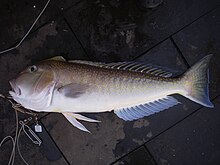| Great northern tilefish | |
|---|---|

| |
| Scientific classification | |
| Domain: | Eukaryota |
| Kingdom: | Animalia |
| Phylum: | Chordata |
| Class: | Actinopterygii |
| Order: | Acanthuriformes |
| Family: | Malacanthidae |
| Genus: | Lopholatilus |
| Species: | L. chamaeleonticeps
|
| Binomial name | |
| Lopholatilus chamaeleonticeps Goode & T. H. Bean, 1879
| |
The great northern tilefish (Lopholatilus chamaeleonticeps) or golden tile, is the largest species in the family Malacanthidae (tilefishes). It grows to a length of between 38 and 44 inches (970 and 1,120 mm). The great northern tilefish is a slow-growing and long-lived species that has four stages of life. After hatching from eggs, the larvae are found in plankton. As they grow into juveniles, the individuals seek shelter until finding or making their own burrows. As adults, the tilefish continue to expand their burrows in the sediment throughout their lives. The diet of the larvae is unknown, but presumed to consist of zooplankton; juveniles and adults feed upon various benthic invertebrates, crustaceans, and fish. After reaching sexual maturity between 5 and 7 years of age, females lay eggs throughout the mating season for the male to fertilize, with each female laying an average of 2.3 million eggs.
The great northern tilefish fishery has been regulated to prevent overfishing. Regulations include catch limits and gear restrictions to prevent damage to the species' habitat and population. The result of these regulations has been a rebounding of the population, which led to an increase in the 2012 catch limit in the southern part of the Atlantic seaboard.[Note 1]
- ^ Aiken, K.A.; Collette, B.; Dooley, J.; Kishore, R.; Marechal, J.; Pina Amargos, F.; Singh-Renton, S. (2015). "Lopholatilus chamaeleonticeps". IUCN Red List of Threatened Species. 2015: e.T16545046A16546277. doi:10.2305/IUCN.UK.2015-4.RLTS.T16545046A16546277.en. Retrieved 19 November 2021.
- ^ "About us". South Atlantic Fishery Management Council. Archived from the original on 20 February 2012. Retrieved 23 July 2013.
Cite error: There are <ref group=Note> tags on this page, but the references will not show without a {{reflist|group=Note}} template (see the help page).
